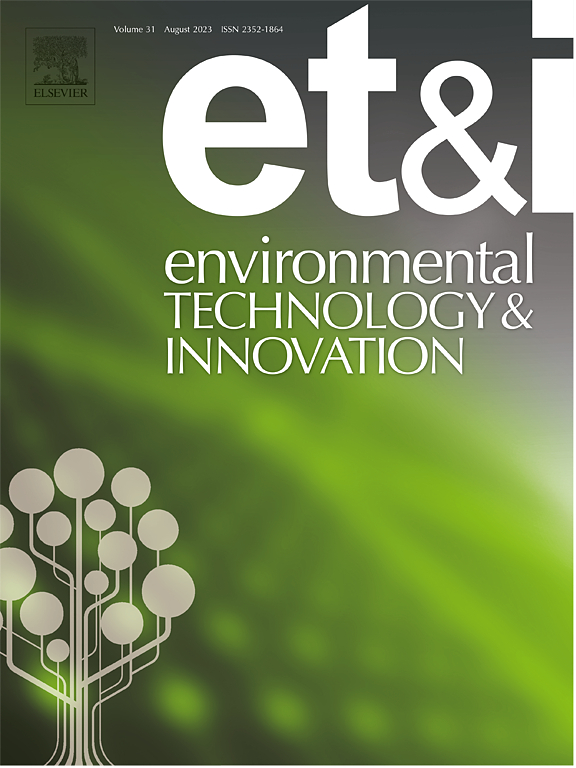Combined effects of Cd and Cr pollution on Eisenia fetida: Influence of soil texture and toxicological mechanisms
IF 6.7
2区 环境科学与生态学
Q1 BIOTECHNOLOGY & APPLIED MICROBIOLOGY
引用次数: 0
Abstract
Soil heavy metal co-contamination poses a global threat to soil ecosystems, yet the texture-dependent interactions between cadmium (Cd) and chromium (Cr) in earthworm toxicity remain poorly quantified. This study integrates quadratic saturated D-optimal design with ecotoxicological assays to unravel how soil texture modulates Cd2 +-Cr6+ synergistic effects on Eisenia fetida. Median lethal concentrations (LC50) of Cd2+ in loam and loamy-clay soils increased by 69.4 and 87.5 % compared to sandy soil, while Cr6+ LC50 values rose by 49.7 and 56.4 %, respectively. Growth inhibition rates (GIR) under combined pollution reached 77.9, 70.8, and 25.3 % in sandy, loam, and loamy-clay soils, respectively, inversely correlating with clay content (p < 0.05). Synergistic Cd2+-Cr6+ interactions dominated in low-clay soils, whereas clay-mediated adsorption attenuated toxicity via electrostatic binding, SEM-EDS analysis revealed significant differences in Cd and Cr distribution in earthworms among the three soils. GIR or biomarkers demonstrated significantly positive correlation with Cd2+ or Cr6+ concentration, and negative with clay content. This study establishes a quantitative framework linking soil texture to Cd/Cr bioavailability, offering critical guidance for region-specific ecological risk assessment.
镉和铬污染对臭Eisenia fetida的联合效应:土壤质地的影响及毒理机制
土壤重金属共污染对土壤生态系统构成全球性威胁,但对蚯蚓毒性中镉(Cd)和铬(Cr)的结构依赖相互作用仍缺乏定量研究。本研究将二次饱和d优化设计与生态毒理学分析相结合,揭示了土壤质地如何调节Cd2 +-Cr6+对肥Eisenia fetida的协同效应。壤土和壤土中Cd2+的中位致死浓度(LC50)比沙土分别提高了69.4和87.5 %,Cr6+的中位致死浓度(LC50)分别提高了49.7%和56.4% %。复合污染条件下,沙质、壤土和壤土-粘土土壤的生长抑制率分别为77.9、70.8和25.3 %,与粘土含量呈负相关(p <; 0.05)。Cd2+-Cr6+的协同相互作用在低粘土土壤中占主导地位,而粘土介导的吸附通过静电结合减弱毒性。SEM-EDS分析显示,三种土壤中蚯蚓体内Cd和Cr的分布存在显著差异。GIR或生物标志物与Cd2+或Cr6+浓度呈显著正相关,与粘土含量呈显著负相关。本研究建立了土壤质地与Cd/Cr生物有效性联系的定量框架,为区域生态风险评估提供了重要指导。
本文章由计算机程序翻译,如有差异,请以英文原文为准。
求助全文
约1分钟内获得全文
求助全文
来源期刊

Environmental Technology & Innovation
Environmental Science-General Environmental Science
CiteScore
14.00
自引率
4.20%
发文量
435
审稿时长
74 days
期刊介绍:
Environmental Technology & Innovation adopts a challenge-oriented approach to solutions by integrating natural sciences to promote a sustainable future. The journal aims to foster the creation and development of innovative products, technologies, and ideas that enhance the environment, with impacts across soil, air, water, and food in rural and urban areas.
As a platform for disseminating scientific evidence for environmental protection and sustainable development, the journal emphasizes fundamental science, methodologies, tools, techniques, and policy considerations. It emphasizes the importance of science and technology in environmental benefits, including smarter, cleaner technologies for environmental protection, more efficient resource processing methods, and the evidence supporting their effectiveness.
 求助内容:
求助内容: 应助结果提醒方式:
应助结果提醒方式:


